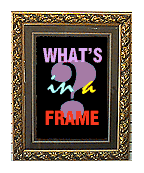
Framing II
Framing III
Framing IV
Framing V
Framing VI
Framing VII
Framing VIII
What's in a Frame?
What's in a Frame?
 Or perhaps I should ask, "Of what does a frame consist?"
Here's my definition:
Or perhaps I should ask, "Of what does a frame consist?"
Here's my definition:
A frame is a psychological device that offers a perspective and manipulates salience in order to influence subsequent judgment.
You'll notice this definition consists of three separate components:
1) A frame "offers a perspective." It manages the viewer's
alignment in relation to the issue. Picture frames on expensive
artwork are often deep to ensure that the viewer examines the
artwork from a limited perspective. . . a perspective that flatters
the artwork, of course. Just as a picture frame can obscure a
painting from an oblique view, so a psychological frame invites
the observer to view the topic from a certain perspective. By
labeling ground beef as "75% lean" rather than "25%
fat," for example, researchers Levin & Gaeth (1988)
were able to impel people to consider meat in terms of its positive
healthful qualities.
2) A frame "manipulates salience." That is, it directs
the viewer to consider certain features and ignore others. A
picture frame sets the artwork apart from the wallpaper. A psychological
frame, however, encourages the observer to attend to a feature
of the stimulus within the frame, while disregarding other features
of that same stimulus which lie outside the frame. To borrow
the language of the Gestaltists, a frame emphasizes 'figure'
at the expense of 'ground.' For example, referring to someone
as "blue collar" or "intellectual" or "an
athlete" emphasizes one particular feature of that person.
Perception may become organized around the label.
3) A frame influences "subsequent judgment." The frame
precedes a persuasive attempt, and implies a certain organization
for the information that follows. A story tells of a Florentine
patron of the arts who took a beautiful picture frame to Leonardo
da Vinci and asked him to paint a picture that would fit within
it. Ludicrous as this sounds, a successful psychological frame
operates in precisely this fashion. Information received after
the frame is delivered may be organized and resized to fit within
the parameters established by the frame. The frame not only contains,
but constrains. The frame helps create the picture we view.

Framing has recently enjoyed a renaissance of investigation in the social psychological literature. This line of research appears to have grown from a peripheral treatment in a paper on decisions under risk published by Kahneman & Tversky in 1979. Since then, social psychology has pursued the topic in much the same way it was presented by Kahneman & Tversky; however, communications and marketing have studied the phenomenon more broadly, and the scientific community is beginning to render the topic with the richness and diversity that this venerable topic deserves.
"Venerable," because what we call "framing" Aristotle called "atechnoi" and Cicero called "statis." Cicero was known to be a particular aficionado of the framing technique, and his lawyerly reputation in ancient Rome was based in part on his ability to demonstrate murdering villains as laudable patriots and have them subsequently acquitted (Pratkanis & Aronson, 1992). What we in science are beginning to understand with methodological rigor, successful practitioners of influence from Cicero to Johnny Cochran have used with intuitive dexterity for centuries. But to take persuasive techniques from the intuitive ether and transform them into reliable, predictable incarnations is the task of social science. Let's continue our examination of framing with the seminal 1979 Kahneman & Tversky study.
www.workingpsychology.com
All rights reserved.
